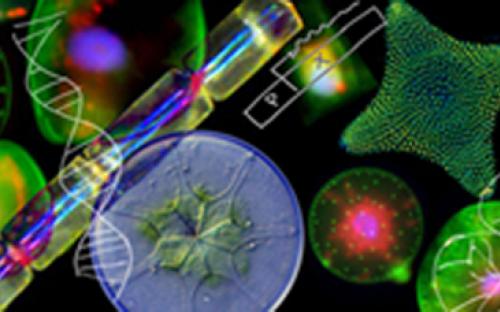- Home
- About
- OSD
- MyOSD
- Partners
- Work Packages
- WP 1Management & Coordination
- WP 2 (OSD)Ocean Sampling Day
- WP 3Oceanography & Environmental Data
- WP 4Standards and Interoperability
- WP 5Bioinformatics & Data Integration
- WP 6Exploring Ecosystems Biology
- WP 7Function and Biotechnology
- WP 8Intellectual Property (IP) Management for Marine Bioprospecting
- WP 9Dissemination & Outreach
- Public DeliverablesAll Micro B3's public deliverables
- Meetings
- Workshops
- Third Micro B3 Industry Expert Workshop
- Micro B3 Industry Expert Workshop
- Micro B3/OSD Analysis Workshop
- Micro B3 Stakeholder Workshop
- Micro B3 Summer School in Crete 2014
- Marine Metagenomics Bioinformatics
- Micro B3 Industry expert workshop
- EU-US Training 2013
- Micro B3 Statistics Training 2013
- MG4U Bioinformatics Training 2013
- Bioinformatics Training 2012
- EU-US Training 2012
Exploring Ecosystems Biology
Rationale and objectives
Bioinformaticians have already developed statistical tools to position genes on phylogenetic trees and metabolic networks, and to establish correlations between environmental parameters, evolution and global metabolic activities of bacterial populations in the oceans, e.g., using data from Craig Venter’s Global Ocean Survey (GOS). But these approaches obviously need now to be extended to other functions and to other organisms present in marine microbial ecosystems, such as viruses and protists. A completely new form of life termed girus (for giant virus) has recently been discovered in marine environments, further indicating our ignorance of marine microbial community composition and function.
Although the ecological understanding of large biological datasets in their environmental context is a daunting task, the high level of complexity and natural fluctuation in natural systems can now be addressed and explored using a combination of high-throughput sequencing technology, correlated contextual data, and multivariate statistical algorithms. Such approaches can provide a valid and productive means to address global scale questions in terms of diversity patterns and of the main factors structuring them, as well as of emerging ecosystem compositions and functions. Investigation of the global patterns of species adaptation and functional diversity within marine microbial communities will require correlative studies of genomic, phylogenetic, and morphological data. For example, comparative metagenomics and metatranscriptomics approaches permits the investigation of the variation of the functional ‘parts list’ available for each sampled community and the study of the active, expressed gene pool in different marine environments. Transformation of such studies into knowledge of marine microbial ecosystem function furthermore requires interpretation of biological information in its environmental oceanographic context.
WP 6 participants work together to unite the fields of molecular microbiology and ecology to develop an understanding of community function by relating biodiversity with the functional structure of the ecosystem. In addition to data analysis, the work therefore includes modelling, to improve the biology parameter space within physico-chemically driven ocean and climate models, as well as some experimental validation, where necessary. The outputs from WP 6 are used to enrich studies at other sampling sites in WP 2, and to provide new leads for biotechnology in WP 7.
Expected impacts include a better understanding of marine microbial ecosystems in terms of their complexity, the parameters driving their functioning, and their effects on and sensitivity to climate change.
Recent discoveries in marine microbial diversity related to Micro B3
- Vaulot et al. 2012. Metagenomes of the picoalga Bathycoccus from the Chile coastal upwelling. PLoS ONE 7:e39648.
- Thompson et al. 2012. Unicellular cyanobacterium symbiotic with a single-celled eukaryotic alga. Science 337:1546-50.
- De Monte et al. 2013. Can we detect oceanic biodiversity hotspots from space? ISMEJ 1-3 doi:10.1038/ismej.2013.72
- Bœuf et al. 2013. Summer community structure of aerobic anoxygenic phototrophic bacteria in the western Arctic Ocean. FEMS Microbiol. Ecol. doi:10.1111/1574-6941.12130.
- Hingamp et al. 2013. Exploring nucleocytoplasmic large DNA viruses in Tara Oceans microbial metagenomes. The ISME Journal. 1-18. doi:10.1038/ismej.2013.59.
Recent progress
To address these challenges, participants in this WP are working together to explore marine ecosystems from both biodiversity and systems biology perspectives. A range of case studies have been chosen that are representative of current activities related to exploration of marine microbial ecosystems on both temporal and spatial scales, and which have specific needs in terms of bioinformatic developments.
Spatial monitoring is provided by worldwide samples available at the partner institutes, including the Tara Oceans and Malaspina expeditions. Temporal monitoring programmes will include the L4 (Plymouth), Blanes Bay (Barcelona), Naples, and Heraklion long term sampling sites. An additional case study consists of the analysis of sediment samples and deep-sea anoxic hypersaline lakes.
This WP is cooperating with WPs 2 to 5 (WP 2 Ocean Sampling Day, WP 3 Oceanography & Environmental Data, WP 4 Standards and Interoperability, WP 5 Bioinformatics & Data Integration) in terms of datasets, analytical tools and interoperability. Tools being developed are used to investigate the functional biodiversity of the marine microbes in each case study.
Progress on viral genome work: Environmental virus samples are ideal candidates for metagenomic analyses, with the small genome sizes of viruses facilitating the reconstruction of their genomes. Nevertheless, viral diversity is poorly represented in the existing reference databases and although viruses have a major role in marine ecosystems, their large diversity makes them still poorly known. The use of metagenomics seems promising to enrich our knowledge on virus genetic diversity. Still, information about viruses is dispersed in several databases and is occasionally inaccurate.
In the first period we tried to extend viral sequence annotations, and to compile virus related information in one database: the Micro B3 Viral genomes DB. This new database facilitates annotation of metagenomic datasets and biological interpretation of the results, especially for co-occurrence studies.
An open access paper on the issue was published in the ISME Journal in April 2013, with the title “Exploring nucleo-cytoplasmic large DNA viruses in Tara Oceans microbial from which one graph is shown below.
Metagenome-based relative abundance of NCLDV (giant viruses) and cellular genomes in the Tara Oceans pyrosequence (TOP) data set (Hingamp et al. 2013, doi: 10.1038/ismej.2013.59). Seventeen TOP metagenomes (0.2–1.6 mm size fraction) were pooled and analyzed as a single data set to generate this plot. Each dot in the plot represents the density of one of the marker genes used in this study (16 markers for NCLDVs and 35 markers for cellular genomes). The estimated abundance of NCLDVs genomes is slightly lower than that of Archaea genomes and amounts to approximately 3% of bacterial genomes.
In summary, the availability of metagenome information for viruses and giruses from WP6, together with the bioinformatics tools developed by WP5, represent important resources that can subsequently be used to address a range of specific questions, such as:
- What is the relationship between abundance and activity of viruses and giruses and between hosts and viruses/giruses? (both to be explored by CNRS)
- What is the impact of lysogeny versus lytic cycles in marine prokaryotic communities? (to be explored by CSIC)
More information on work with virus genomes can be found in the report on re-annotation of reference viral and giral genomes (public deliverable D6.1), done in cooperation with CSIC.
Diatoms: CNRS-ENS is working specifically with the sequences assigned to diatoms, one of the most important groups of eukaryotic phytoplankton. From the 36 sampling sites, a picture has already emerged of diatom abundance and diversity. Additionally, within WP 7 diatom gene annotation has been improved, which is also improving our capacity to understand diatom functions in their environment.
Ecological analyses: Cooperation between work packages was furthermore promoted through the Interactive Ecological Analysis Guide (IEAG) and the Ecological Analysis Tools for Microbial Ecology (EATME). While these tools are developed in WP 5, the review, evaluation, and synthesis of their content is being addressed as part of WP 6. Furthermore, a recent training course in multivariate analyses in WP9 featured the use of the IEAG as a instruction aid. Feedback from course participants was used to further tailor the IEAG to the needs of the Micro B3 consortium.
The range of methods that will soon become available in the EATME package, being developed by partner AWI, will include approaches to explore the ecological factors underlying the different rank-abundance patterns observed at different sites. Like the IEAG, EATME aims to aid researchers in selecting and applying appropriate analyses to their data.
Lead of WP 6: Chris Bowler, Centre National de la Recherche Scientifique




